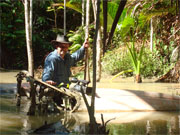 In 2003, I had the privilege of meeting retired Air Force Colonel Charles P. O’Sullivan. I had been sent to interview O’Sullivan for a small scale video project with a local military museum. After the interview, Col. O’Sullivan began to tell me a harrowing tale – his own survival story from World War II. He had crashed his fighter plane in the In 2003, I had the privilege of meeting retired Air Force Colonel Charles P. O’Sullivan. I had been sent to interview O’Sullivan for a small scale video project with a local military museum. After the interview, Col. O’Sullivan began to tell me a harrowing tale – his own survival story from World War II. He had crashed his fighter plane in the jungle wilds of New Guinea, sought help from local natives, and then shot his way out of their village when they attacked him, killing two prominent members of their tribe. For thirty days he wandered the jungle, hunted by angry villagers while encountering natural dangers as well. O’Sullivan lost his boots while retreating from the natives. He escaped a large prairie fire he started while trying to signal to planes overhead. At one point he found himself grasping to a vine to prevent drowning in a fast-moving river! Eventually, he made his way to a friendly Australian outpost and was returned home. jungle wilds of New Guinea, sought help from local natives, and then shot his way out of their village when they attacked him, killing two prominent members of their tribe. For thirty days he wandered the jungle, hunted by angry villagers while encountering natural dangers as well. O’Sullivan lost his boots while retreating from the natives. He escaped a large prairie fire he started while trying to signal to planes overhead. At one point he found himself grasping to a vine to prevent drowning in a fast-moving river! Eventually, he made his way to a friendly Australian outpost and was returned home.
 I was immediately interested in the story and called O’Sullivan soon after to inquire of his interest in seeing this story played out on-screen in a video documentary. He agreed to the idea, and we began from that point to develop the concept that would become Injury Slight…Please Advise, a title taken from the radio message he sent to his squadron upon his arrival at the Australian camp. I obtained a very detailed, printed version of his story that he had written down and began detailing the project from that point. I was immediately interested in the story and called O’Sullivan soon after to inquire of his interest in seeing this story played out on-screen in a video documentary. He agreed to the idea, and we began from that point to develop the concept that would become Injury Slight…Please Advise, a title taken from the radio message he sent to his squadron upon his arrival at the Australian camp. I obtained a very detailed, printed version of his story that he had written down and began detailing the project from that point.
It was then that I learned an interesting piece of trivia about this story. In 1993, nearly 50 years to the day that Charles O’Sullivan crash-landed his P-38 Lightning, the wreckage of his plane was discovered in a remote swamp in Papua New Guinea. From a filmmaker’s perspective, inclusion of this rare find in the finished documentary was critical. I adjusted our production budget and shooting schedule to include a photographic mission to New Guinea, but shooting in such a remote part of the world would be  anything but easy! anything but easy!
The first step was to locate someone with experience and local contacts who could successfully lead a team to the crash site. This task was accepted by Steve Cushman of Go Remote, Inc. Steve had been credited with the discovery of another P-38 Lightning in New Guinea and was eager to be involved with such an amazing story as O’Sullivan’s crash and encounter with the natives. After two years of planning, Steve and I finally entered the Ramu River Valley in New Guinea in search of Charles O’Sullivan’s P-38.
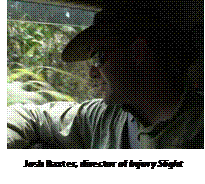 Arriving in New Guinea, we made contact with a local businessman well versed in wreck hunting. A field guide was supplied to us and made arrangements to travel to a mission station near the wreck site. Fifty miles of mountainous roads led from our starting point to the Ramu Valley. The weather had changed from its usual dry season and rains had permeated the area. The Ramu is unpredictable, and local warnings abound describing flash floods and sudden shifts in the course of the river. Locating this wreck was one thing, but actually reaching it was a different endeavor altogether! Arriving in New Guinea, we made contact with a local businessman well versed in wreck hunting. A field guide was supplied to us and made arrangements to travel to a mission station near the wreck site. Fifty miles of mountainous roads led from our starting point to the Ramu Valley. The weather had changed from its usual dry season and rains had permeated the area. The Ramu is unpredictable, and local warnings abound describing flash floods and sudden shifts in the course of the river. Locating this wreck was one thing, but actually reaching it was a different endeavor altogether!
Steve and I set out on foot in early morning light to begin our trek through the jungle. We had been advised that the hike in would take about two hours. We planned accordingly, bringing enough water to last six hours, as well as a small first aid kit and a few other odds and ends. For the most part we traveled light. Four porters carried our two bags of camera equipment and led us with our guide to the wreck site.
Our first obstacle was a swift-moving river that had swelled during the night due to unseasonable rains. As I stepped into the Tauya River, it occurred to me that this was the same river O’Sullivan had crossed – nearly drowned in – while he made his escape from the jungle. For us it would be 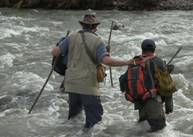 the most dangerous obstacle of the day. Crossing a Class-3 rapids on foot while trying to run a video camera is not as easy as it looks! the most dangerous obstacle of the day. Crossing a Class-3 rapids on foot while trying to run a video camera is not as easy as it looks!
We entered a small village as we left the river behind us. The villagers were curious at our arrival, and welcomed us with generous hospitality. After a brief visit we continued on, the heat and humidity already noticeable in the early morning hours.
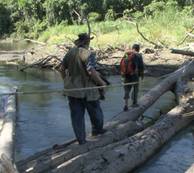 Walking in the jungle was not that difficult. The ground was level and dry. A path had been cleared and our guides were well familiar with their surroundings. At times the palm leaves and other vegetation engulfed us, but before long we were standing at the high banks of the Marea River, our second obstacle of the day. O’Sullivan had described this river as a “drinking stream,” and that it was. Calm and beautiful, the Marea reminded me of many of our small rivers and streams back home. A collection of downed trees formed a footbridge across the river, and with little trouble we were on our way to the last landmark between us and the wreck, a large stand of kunai grass. Walking in the jungle was not that difficult. The ground was level and dry. A path had been cleared and our guides were well familiar with their surroundings. At times the palm leaves and other vegetation engulfed us, but before long we were standing at the high banks of the Marea River, our second obstacle of the day. O’Sullivan had described this river as a “drinking stream,” and that it was. Calm and beautiful, the Marea reminded me of many of our small rivers and streams back home. A collection of downed trees formed a footbridge across the river, and with little trouble we were on our way to the last landmark between us and the wreck, a large stand of kunai grass.
We noticed that time was ticking by quite a bit faster than we had planned. Every time we asked our guides, “How much longer?” they responded with the same answer – “half an hour…”
Kunai grass is abundant in the Ramu River Valley. After crossing the Marea River I began to search for the tall reeds of grass, thinking that each one I saw might be the edge of the large field described in O’Sullivan’s story. When he crashed in 1943, he chopped and pushed his way through 700 yards of this grass after leaving his plane, taking nearly four hours to reach a nearby tree line.
We were getting hot, and our shirts were soaked with sweat. Our water breaks were becoming more frequent, and our supply was beginning to dwindle. At one point 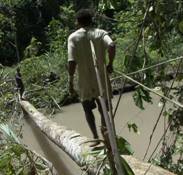 through a break in the tree line I saw a thick clump of kunai grass. My heart began to race – we had to be getting close! At that moment I stepped out of the thickness of the jungle where the path ended at the Ramu River. through a break in the tree line I saw a thick clump of kunai grass. My heart began to race – we had to be getting close! At that moment I stepped out of the thickness of the jungle where the path ended at the Ramu River.
According to all of our research, we should never have encountered the Ramu while trekking to the wreck site. Of course, the most recent information about a specific location in New Guinea may be two or three years old by the time it reaches the U.S. It was at this point that we learned the Ramu had made a drastic change in its course two years earlier during a series of heavy storms. Fortunately for us, our guides had felled a large tree across the river, about five feet above the waters, spanning nearly 50 feet across to the other side. While we waited, the locals constructed a handrail of sorts using long vines cut from nearby trees.
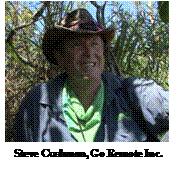 As we carefully stepped across the Ramu, the large field of kunai grass finally appeared in the distance. Moving closer to the kunai, it became evident that the field had been recently burned off, making our hike much easier. The small bit of grass that we did push through was formidable, ten feet tall and very thick. I imagined how difficult it must have been for O’Sullivan in 1943, alone and wounded, to find his way through 700 yards of this impossible grass. On the other side of the field we came to the edge of a swamp – murky and dark – the final resting place of O’Sullivan’s P-38 Lightning, Mareelee II. As we carefully stepped across the Ramu, the large field of kunai grass finally appeared in the distance. Moving closer to the kunai, it became evident that the field had been recently burned off, making our hike much easier. The small bit of grass that we did push through was formidable, ten feet tall and very thick. I imagined how difficult it must have been for O’Sullivan in 1943, alone and wounded, to find his way through 700 yards of this impossible grass. On the other side of the field we came to the edge of a swamp – murky and dark – the final resting place of O’Sullivan’s P-38 Lightning, Mareelee II.
In a sudden moment I found it difficult to breathe. The heat was overwhelming. There was no breeze. My water supply was almost exhausted and I realized I was in trouble. Steve was in similar condition, and we sat under a small tree, the only shade we could find. For an hour we lay, semi-conscious, while our guides filled our empty water bottles from the muddy Ramu River. It had been six hours since we set out that morning – a far cry from the two hours we had expected. The river water was not drinkable, but did cool us down as we poured it down our backs and over our heads. At one point Steve made mention that we were being scouted by buzzards, four of them, circling overhead.
After a long rest we were ready to enter the swamp. One of our guides had waded in through the mud and returned with a few snapshots of the plane. Most noticeable to us were the two leeches attached to his leg that he had picked up in the swamp. As we waded in ourselves, our feet sunk into knee-deep mud. The murky swamp water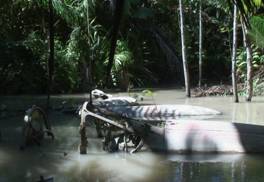 rose to our waists. At one point, I had to remove my water shoes to keep from losing them in the mud. I nestled them securely under a small tree to retrieve them later, taking careful steps in my bare feet the rest of the way. rose to our waists. At one point, I had to remove my water shoes to keep from losing them in the mud. I nestled them securely under a small tree to retrieve them later, taking careful steps in my bare feet the rest of the way.
Mareelee II sat three feet deep in the waters adjacent to the Ramu River, a hundred yards into the swampy lair that has sheltered her from view for over sixty years. It had been four years since I first learned of her coming to rest in this spot, and seeing her in person brought a flood of emotion.
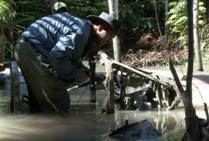 The twenty minutes we spent at the wreck site was surreal. I stood in the cockpit where O’Sullivan once sat, trying in vain to turn the rusted control wheel, amazed that the gauges were still intact on the instrument panel. I noticed details of the wreck that I had only seen in pictures taken at its initial discovery. I picked up my camera and began to shoot anything and everything I could see about the wreck. Considering that the largest part of the plane was under water, my footage was limited. But to know that I have stood at the site, and re-traced the steps of a true hero is something I will carry with me for the rest of my life. The twenty minutes we spent at the wreck site was surreal. I stood in the cockpit where O’Sullivan once sat, trying in vain to turn the rusted control wheel, amazed that the gauges were still intact on the instrument panel. I noticed details of the wreck that I had only seen in pictures taken at its initial discovery. I picked up my camera and began to shoot anything and everything I could see about the wreck. Considering that the largest part of the plane was under water, my footage was limited. But to know that I have stood at the site, and re-traced the steps of a true hero is something I will carry with me for the rest of my life.
We left the wreck almost as soon as we arrived. It was well after 3:00 p.m. and nightfall would catch us before we returned to our starting point. The Marea River, Col. O’Sullivan’s “drinking stream,” was our salvation. The water was clean and sweet, and we refilled our water bottles at that spot. We stopped at one point to refresh ourselves with sugar cane that one of our guides had cut for us. Having lost a lot of water from the heat, we faced issues of muscle cramps and dizziness, but our first aid kit helped by supplying electrolyte tablets that enabled us to press on. 
By 8:30 p.m. we were back at the rocky banks of the Tauya River. It was cloudy and dark, the sun having set an hour earlier. A cold rain had cooled us for the last two hours of the hike, aiding us in the jungle but causing the river to swell immensely. Our guides debated over a proper crossing point, and finally mumbled the prospects of swimming across the river in the dark.
I had the only working flashlight. It was bright enough to illuminate the river from one side to the other. The guides strapped on our camera bags and swam the river to a point where they could stand and walk. As Steve and I stepped into the cold river, I wondered how watertight the camera bags were. A thousand thoughts went through my mind and I decided to trust God that He would take care of things. He did.
 At that moment my feet slipped on some loose rocks in the river bottom and the swift current began to pull me downstream. I called to Steve who was a couple of steps ahead and he quickly reached out his walking stick towards me. I grabbed hold of it and steadied myself, then began to trudge against the current towards a gravel bar on the other side. At that moment my feet slipped on some loose rocks in the river bottom and the swift current began to pull me downstream. I called to Steve who was a couple of steps ahead and he quickly reached out his walking stick towards me. I grabbed hold of it and steadied myself, then began to trudge against the current towards a gravel bar on the other side.
We sat on the banks of the Tauya River, drinking rain water from our leather hats and waiting for our guide to bring the truck to pick us up. It was a peaceful time to reflect, thankful for a safe return from an incredible day in the wilds of New Guinea. In all we had walked 14 miles to the wreck site and back in a span of about 14 hours. Our prize was fifteen minutes of footage, memories to last a lifetime, and a tremendous respect for a true hero of our Greatest Generation. |